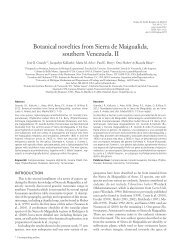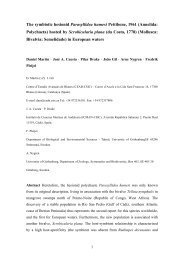FUNCTIONAL AND BIOACTIVE PROPERTIES OF COLLAGEN AND ...
FUNCTIONAL AND BIOACTIVE PROPERTIES OF COLLAGEN AND ...
FUNCTIONAL AND BIOACTIVE PROPERTIES OF COLLAGEN AND ...
You also want an ePaper? Increase the reach of your titles
YUMPU automatically turns print PDFs into web optimized ePapers that Google loves.
ecause upon heating the fish mince portion, the collagenous material gelatinized, giving it a much<br />
more desirable texture than portions without this material.<br />
The application of fish gelatin as an additive in surimi processing to improve water retention in heatset<br />
gels has also been examined. Alaska pollack surimi gels containing 7.5–15 g/kg of fish gelatin<br />
showed improved expressible moisture; however, when 15 g/kg were added it produced a disruptive<br />
effect which proved detrimental to the mechanical properties of the gel, more so when using surimi of<br />
maximum quality (Hernández-Briones, Velázquez, Vázquez & Ramirez, 2009). The gel-forming<br />
capability of threadfin bream (Nemipterus japonicus) mince was substantially increased by adding<br />
gelatin (0.5%) from the skin of bigeye snapper (Binsi, Shamasundar, Dileep, Badii, & Howell, 2009).<br />
In contrast, gelatin additions of 5% and 10% reduced the elastic modulus (G’) values considerably,<br />
possibly due to water molecule entrapment by high gelatin concentrations making them unavailable<br />
for protein gelation. Accordingly, gelatin was considered to be an inactive binder with little or no<br />
interaction between filler particles and gel matrix. However, when examining the gelling profile of<br />
chicken myosin and pork skin gelatin mixtures upon heating from 25 to 80ºC, Yang, Zhou, Xu &<br />
Wang (2007) found that G’ values were significantly higher than those of pure myosin, which meant<br />
that a possible myosin–gelatin interaction, likely of an electrostatic nature, had led to higher gel<br />
elasticity, suggesting the usefulness of this gelatin application in restructured (chicken) meat<br />
products. In a much more simplified application, washed and defatted poultry skin was included in<br />
the formulation of bologna (an emulsified meat product) (Bonifer, Froning, Mandigo, Cuppett &<br />
Meagher, 1996). The authors found that the incorporation of skin (10%) significantly improved<br />
sensory properties (texture, flavour and appearance) without affecting negatively the emulsion<br />
stability or textural parameters in the final product.<br />
4.2.- Surface properties<br />
Collagen and gelatin surface properties are based on the presence of charged groups in the protein<br />
side chains, and on certain parts of the collagen sequence containing either hydrophilic or<br />
hydrophobic amino acids. Both hydrophobic and hydrophilic parts tend to migrate towards surfaces,<br />
hence reducing the surface tension of aqueous systems and forming the required identically charged<br />
film around the components of the dispersed phase, which can be additionally strengthened by gel<br />
formation (Shrieber & Gareis, 2007).<br />
Type A gelatins, with a relatively high isoelectric point (pI≥7.0), are suitable for creating oil-in-water<br />
emulsions with a positive charge over a wider range of pH values than is possible with conventional<br />
protein emulsifiers, such as soy, casein or whey proteins (Dickinson & Lopez, 2001). Early studies<br />
by Kim, Jeon, Lee & Lee (1996) reported that cod bone gelatin had emulsifying properties similar to<br />
those of a commercial emulsifier, such as Tween-80. As is often the case with gelling properties, the<br />
12

















